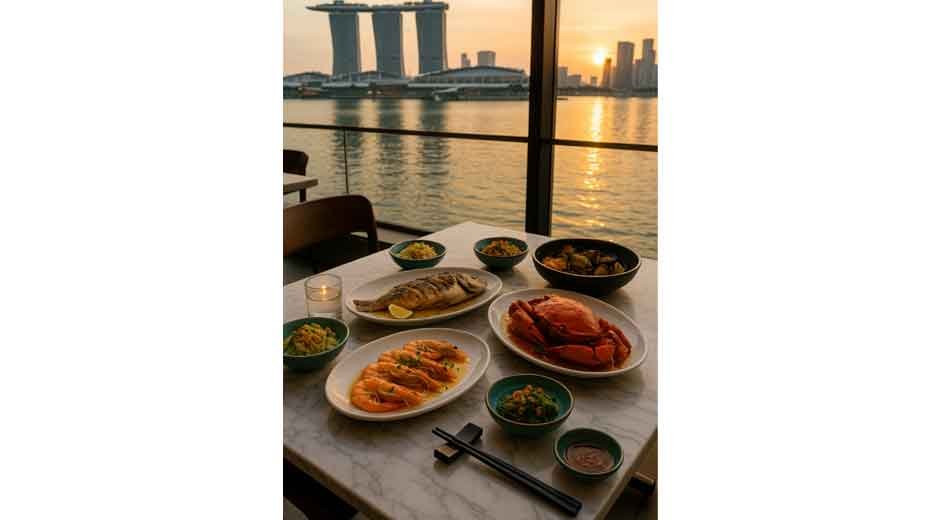Table of Contents
ToggleA Nation Shaped by the Sea
Few cities in the world are as deeply connected to the ocean as Singapore. From the early kampong fishing villages along Bedok and Pulau Ubin to today’s vibrant hawker centers, seafood has remained at the core of the nation’s dining identity. Generations of families have grown up around wet markets, shelling prawns for laksa or cleaning fish for sambal stingray, learning that freshness from the sea is both a tradition and a responsibility.
As the island modernized, that heritage evolved into a diverse, multicultural seafood scene. The Malay influence brought grilled fish and chili pastes; the Chinese community perfected steamed grouper and pepper crab; while Indian and Peranakan kitchens infused seafood with spice blends and coconut milk. Yet amid this culinary abundance, one question continues to gain importance: how can Singapore maintain its seafood legacy sustainably while ensuring that every catch is used wisely?
From Market to Table: A Mindful Shift
Singaporeans today are increasingly aware of where their food comes from. With sustainability and food security becoming national priorities, more consumers are supporting suppliers that source ethically from nearby waters or reputable international fisheries. Restaurants are responding too, adopting nose-to-tail philosophies — an approach once limited to meat — that now extend to fish and shellfish. The goal is simple: minimize waste, honor the entire animal, and rediscover forgotten flavors.
This renewed curiosity about how seafood is prepared and consumed has led to a broader understanding of marine anatomy and cooking technique. Chefs are teaching diners that the sweetest parts of a crab may not be its claws, or that delicate textures often hide beneath shells and fins. It’s this attention to detail — the same curiosity that explores the edible parts of a lobster — that is inspiring Singapore’s culinary world to think more deeply about texture, nutrition, and respect for the catch.
The Science of Taste and Texture
Seafood fascinates chefs because every species offers a unique structure. The muscle fibers in fish are shorter than in land animals, giving them their flaky texture when cooked. Mollusks, with their firm connective tissues, demand different techniques — from slow steaming to quick searing. Shellfish like clams and oysters, rich in glycogen, release natural sweetness when gently heated, a quality that defines many coastal dishes served across Singapore’s East Coast eateries.
Understanding anatomy also deepens appreciation. A whole fish, for instance, can yield over ten distinct textures — from the fatty belly prized for sashimi to the gelatinous cheeks and tender collar often reserved for soup. These subtle differences create a sensory map that chefs use to craft balanced dishes, pairing lighter textures with stronger sauces or delicate cuts with citrus-based dressings.
Singapore’s Sustainable Chefs
In the past decade, a new wave of local chefs has emerged, blending innovation with ethics. Some, like the pioneers behind farm-to-table seafood restaurants in Joo Chiat and Tanjong Pagar, work directly with aquaculture farms that raise grouper and sea bass using eco-friendly systems. Others collaborate with fishermen in Malaysia’s Johor Strait, securing traceable supplies that reduce environmental impact.
These chefs champion every part of the seafood they prepare. Fish bones become flavorful broths; shrimp shells are simmered into bisques; and seaweed by-products transform into umami powders. The movement reflects a distinctly Singaporean value — resourcefulness — adapted for a modern world where culinary artistry meets environmental awareness.
Nutrition from the Sea
Health-conscious diners are also driving this transformation. Seafood provides high-quality protein, omega-3 fatty acids, and minerals essential for brain and heart function. Yet many are discovering that the benefits go beyond the fillet. The collagen in fish skin supports skin elasticity, while calcium-rich shells and cartilage can be repurposed into nutrient-dense stocks. Singapore’s wellness community is beginning to highlight these aspects, blending gastronomy with science to encourage balanced, natural eating habits.
At the same time, dietitians emphasize moderation. While seafood is a cornerstone of healthy diets, overconsumption of certain species can strain ecosystems or expose consumers to higher mercury levels. This awareness has led to a shift toward locally farmed varieties, such as tilapia, barramundi, and mussels — all of which thrive in tropical waters with relatively low environmental impact.
Culinary Traditions That Respect the Whole Catch
Beyond fine dining, everyday Singaporean dishes also embody sustainability. The humble fish soup stall, with its clear broth made from leftover bones, or the prawn mee vendor using shells for flavor, are timeless examples of efficiency born from necessity. This philosophy of using every part of the ingredient remains central to the nation’s street food culture.
Culinary schools and workshops now encourage home cooks to adopt similar habits — teaching deboning, scaling, and marinating techniques that maximize flavor while reducing waste. Social media creators have joined the trend, demonstrating how to prepare seafood at home without discarding valuable portions. These collective efforts are gradually redefining what it means to “eat responsibly” in a modern city-state.
Beyond Taste: Cultural and Emotional Connection
Seafood, perhaps more than any other food group, binds Singaporeans emotionally. Family reunions often feature steamed fish or chili crab as centerpieces of celebration. The act of sharing shells, dipping sauce, and rice reflects a communal dining spirit that transcends ethnicity. Even as fusion cuisine and international influences expand, these roots remain firm — seafood is not merely sustenance but a shared story of survival, adaptation, and pride.
In that sense, learning about the edible parts of a lobster or appreciating the subtle flavors of different fish cuts becomes more than a culinary lesson. It becomes an expression of gratitude — for the fishermen who risk tides, for the hawkers who preserve heritage, and for the diners who choose mindfulness over indulgence. Each meal becomes a small acknowledgment of Singapore’s ongoing relationship with the sea.
Toward a Conscious Future
Singapore’s vision for food resilience — from urban fish farms to sustainability labeling — suggests a future where taste and ethics coexist. Consumers can expect to see more transparency in sourcing, clearer guides for seasonal seafood, and greater emphasis on educational dining experiences. Schools and community groups are beginning to introduce children to marine conservation through cooking lessons, fostering awareness early on.
The next chapter of Singapore’s seafood story will be defined not by abundance, but by balance: savoring without excess, innovating without exploitation, and celebrating without waste. In this evolution, the city-state stands as a model for how a small island can honor its maritime roots while leading Asia’s sustainable dining revolution.
Conclusion
The coastal palate of Singapore tells a tale of progress — from tradition to innovation, from consumption to consciousness. The nation’s love affair with seafood endures, not because of novelty, but because of respect: for flavor, for heritage, and for the environment. Every meal from sea to plate carries a quiet reminder that sustainability begins not in policy, but in choice.
And in every choice — from the hawker stall to the fine-dining table — Singapore continues to prove that mindful eating is not a sacrifice, but an evolution of taste, culture, and care.













